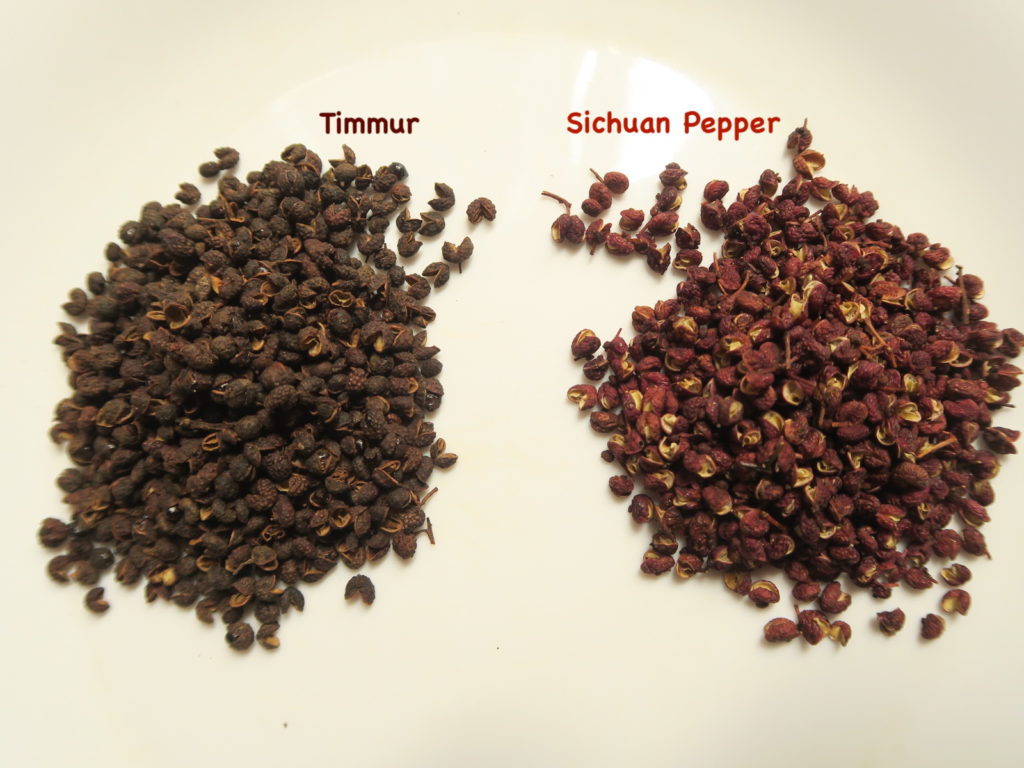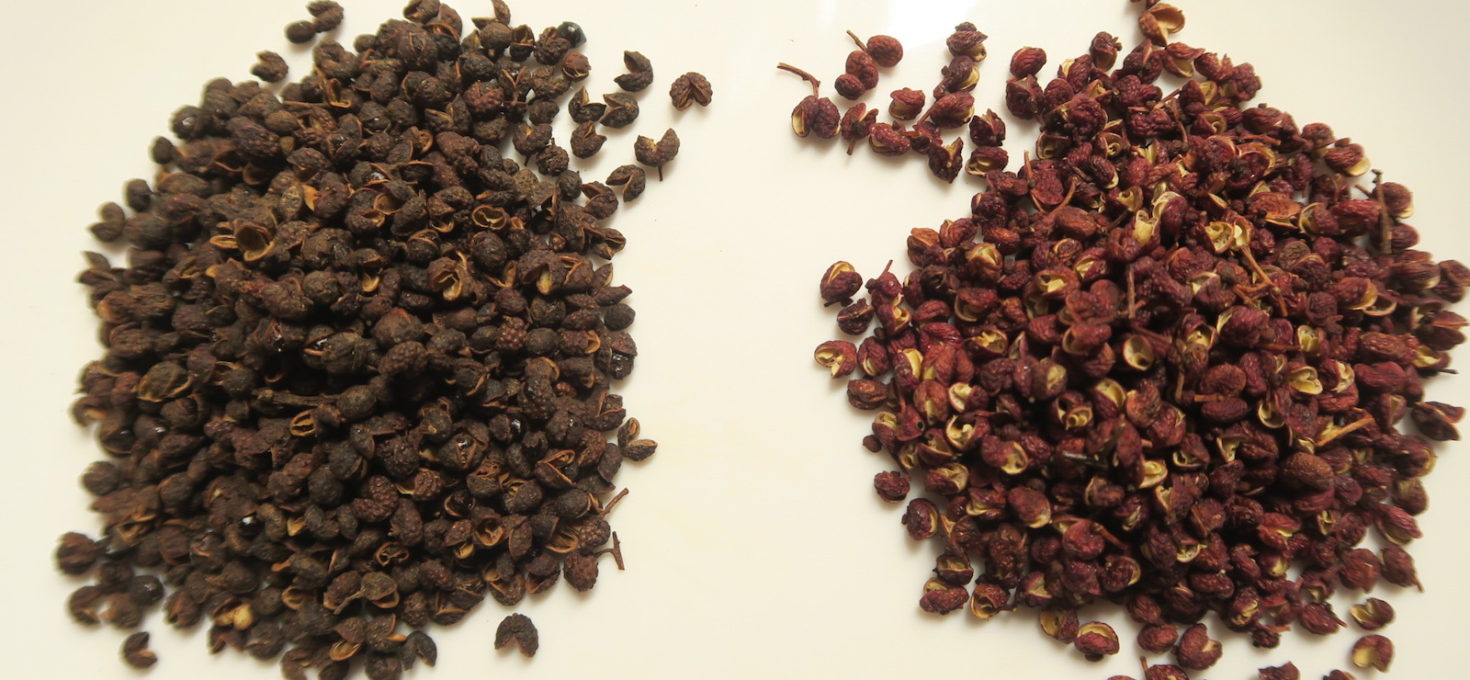Many Nepalis confuse timmur with sichuan pepper and often use the terms alternatively. Timmur and sichuan pepper (the red one commonly referred to) are cousins, they both have numbing characteristics but have entirely different flavor profiles. There are more varieties around the world. Timmur (Zanthoxylum armatum) is dark brown in color and has a strong citrusy flavor whereas sichuan pepper (Zanthoxylum simulans; hong huājiāo in Chinese) is reddish-brown in color and has a flowery herbal flavor. Sichuan pepper generally has a stronger numbing sensation than timmur.

Timmur is found wild in the mid-hills across Nepal. However, it is not just limited to Nepali territory; It is also found in Northeastern India, Yunnan, and as far as Northern Thailand (not sure exactly if the same variety but they have citrusy one). Nepalis, in the hills and mountains, use timmur mainly in flavoring achaar. Timmur slightly roasted in a pan and ground together with salt, chilies, garlic, and roasted tomatoes makes the popular achaar in Nepal.
Not many know, sichuan pepper is also found wild and consumed in Nepal, in Solu and surrounding regions. Sherpas call it “airmong” and use it to flavor soups, noodles, and achaars. Young green airmong are also preserved in oil and salt.

In Sichuan and Yunnan region, sichuan pepper (huājiāo) is extensively used in their cuisine. They even have a specific word for taste that comes from sichuan pepper and chili together “mala” meaning “numb and spicy”. Some popular Sichuan dishes that use sichuan pepper are mapo dofou, sichuan hotpot, liangfen.
There are even more Zanthoxylum varieties around the world.
The other spice known as siltimmur (kattabasi in Newa) found in the eastern mid-hills is not related to timmur. It also has citrusy flavor and its scientific name is Litsea citrate.
Tips for storing timmur and sichuan pepper:
It’s better to store timmur and sichuan pepper whole than grounds. If you grind them, the flavor degrades much faster. In case you want to grind them beforehand for ease, mix the grounds with cooking oil to form a paste and put it sealed in the jar. Oil helps to preserve the flavor and aroma for a longer time.

Zanthoxylum armatum IS a variety of Szechuan (Sichuan) pepper. Zanthoxylum simulans (bungeanum) is another variety.
Refer to the link attached.
https://www.frontiersin.org/articles/10.3389/fpls.2016.00467/full
https://www.plantexplorers.com/vandusen/product_info.php?products_id=469
Growing up, all motorcycles were called Honda, all cars, Toyota. Is that your logic? You can call Timur a Rose, if you want.
Thank you for this post. I just cooked today morning with Timmur and noticed the less tingliness that must come from the sichuan peppers. I removed the onyx seeds from inside the husks and then pan roasted the husks to release the flavors. The seeds give a gritty and sandy texture to dishes when ground in a mortar pestle. Learnt my lesson the hard way. Indeed Timmur has a very different fragrance. It’s quite pungent actually. I will make some chilli oil using the peppers next time.
Bro,,, little bit misguided information. Both Zanthoxylum Armalum and Zanthxylum Simulans are Sichuan Pepper. Their species are different. Like we have different mango with different taste, different size and different species. Like some mango are magnifera indica and some are magnifera odorata. ps: most mango has same genus and species name… I am just giving example.
But I would love if you write Sichuan sauce is no more made with sichuan (Szecuan pepper)..
This is so wrong, it is not funny. Mangifera Indica and Mangifera Odorata don’t both refer to Mango. “All mangos are Mangifera Indica”. Period.
Mangifera Odorata is a completely different fruit. This sort of comment could be vetted in like 15 seconds of checking on wikipedia.
Wow this article was great i love to ready visit my blog https://mynepalifoods.blogspot.com if you are interested to make nepali delicious food.
thanks
I believe that TImmur will be the green Sichuan pepper not the commonly available red Sichuan pepper.
This post is correct. Timur (timur) has a muddy floral scent and tastes like eating potpurri and is not szechuan (Sichuan) peppercorn. It’s more commonly used in middle eastern cooking not Asian cuisines you’re probably familiar with. If you’re not used to it, it smells and tastes really weird and is not a good substitute for szechuan peppercorn.
So, what do you mean when you say of timur “it smells and it tastes really weird”. Szechuan falls into that category, too! Is it too heavy on the citrus flavor of grapefruit? Bitter?
So, what do you mean when you say of timur “it smells and it tastes really weird”. Szechuan falls into that category, too! Is it too heavy on the citrus flavor of grapefruit? Bitter?